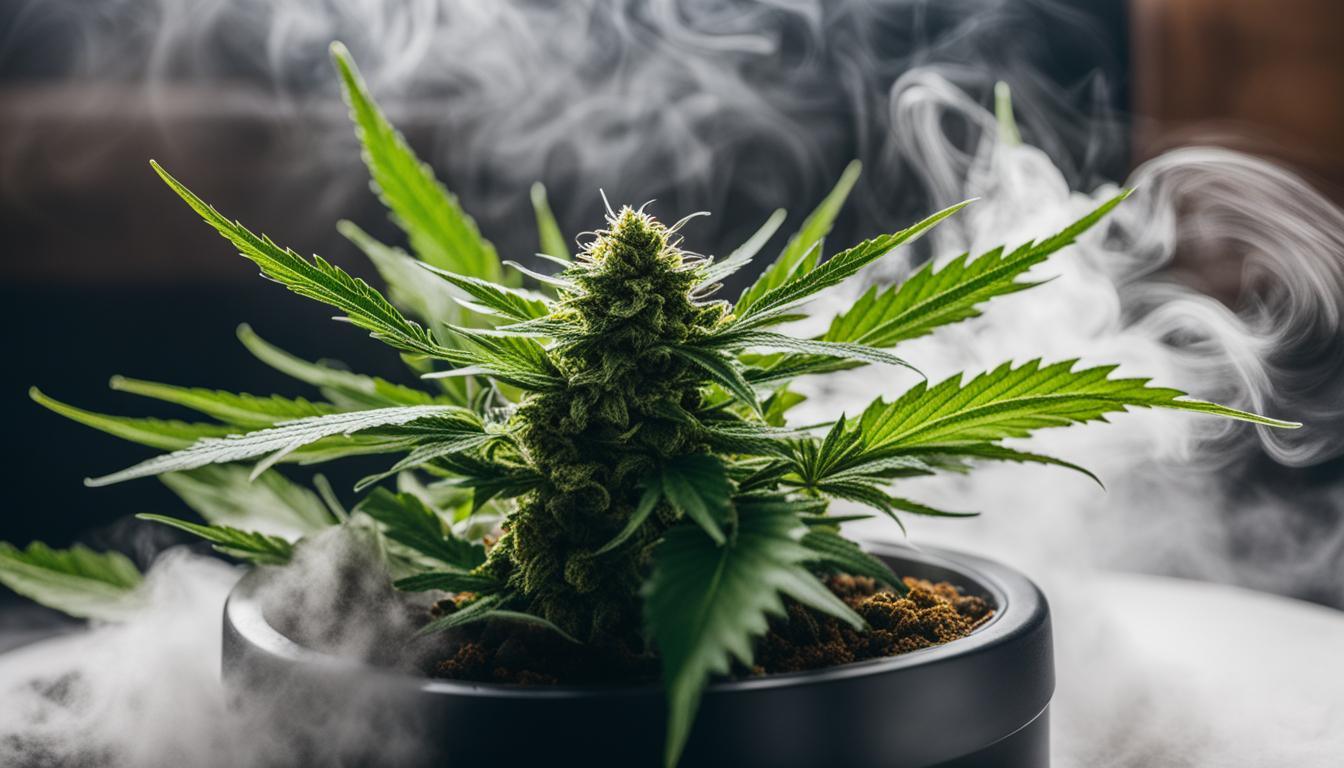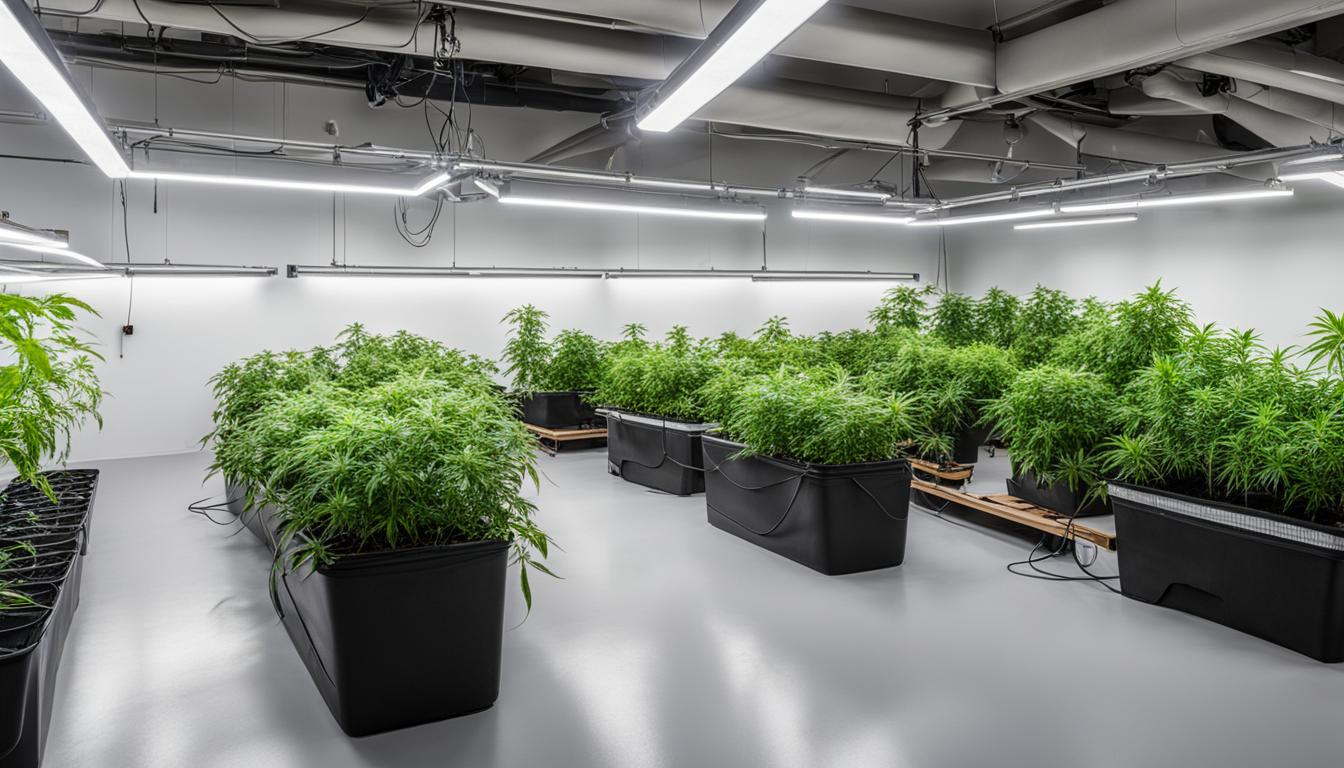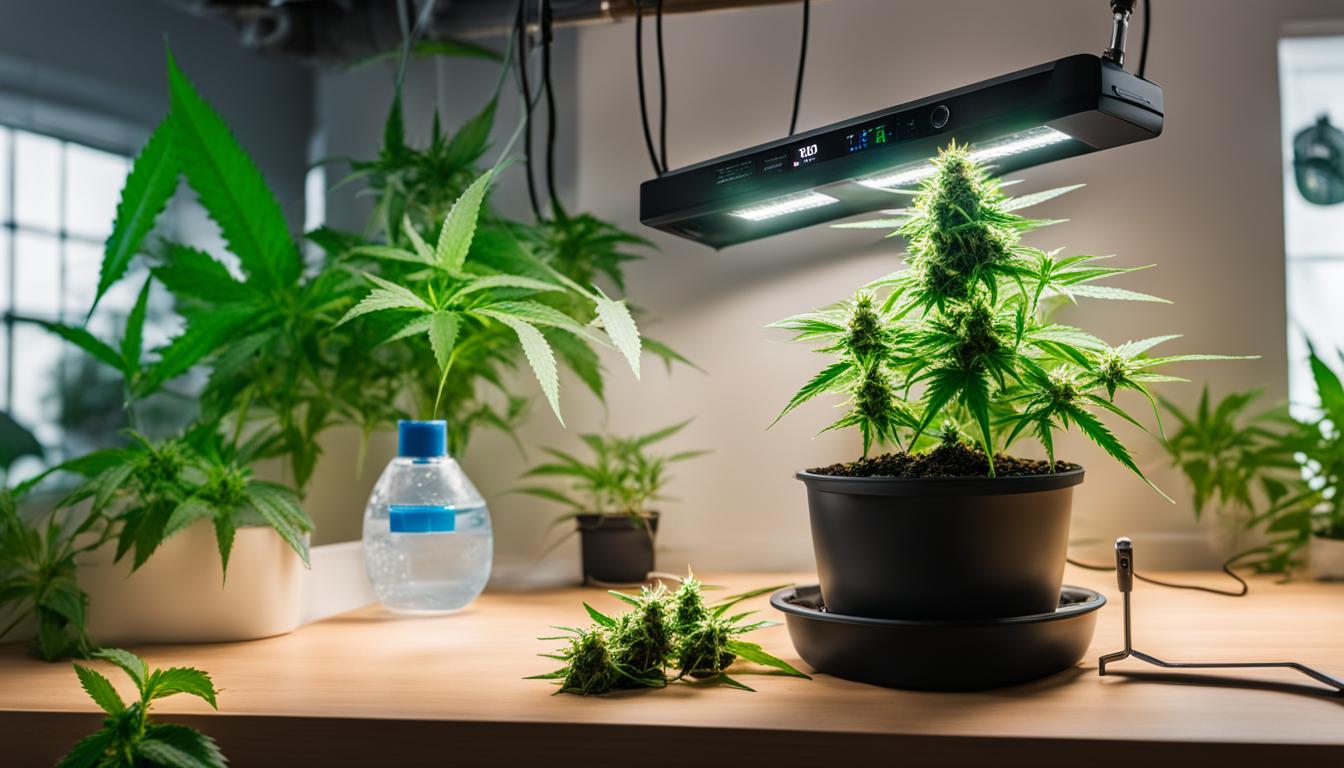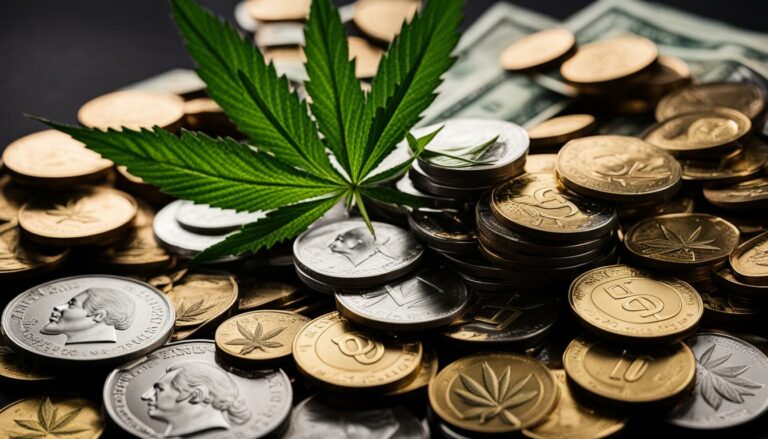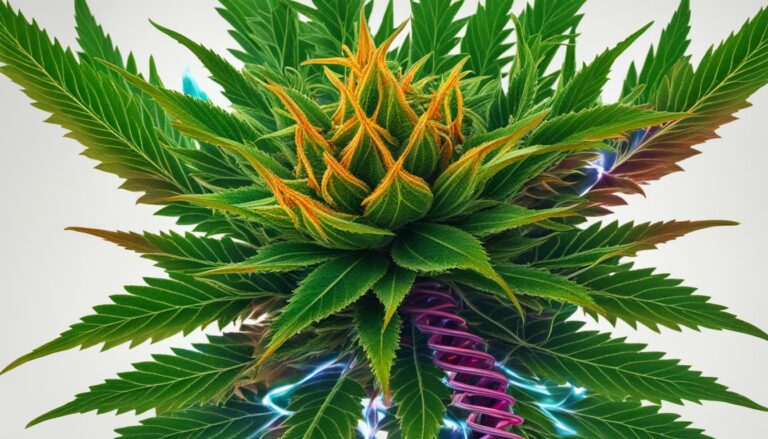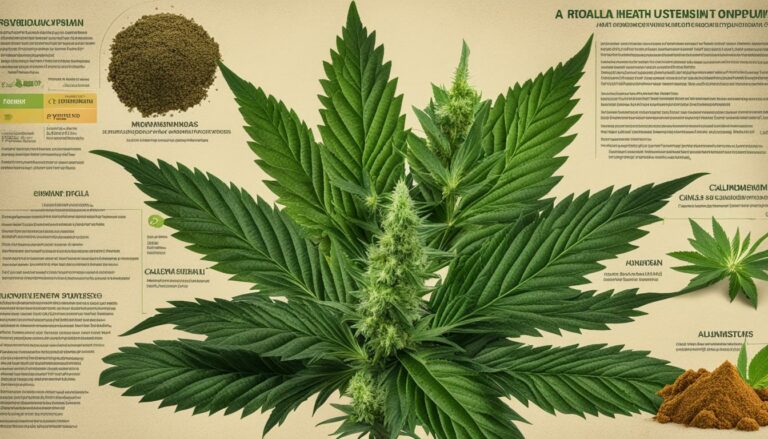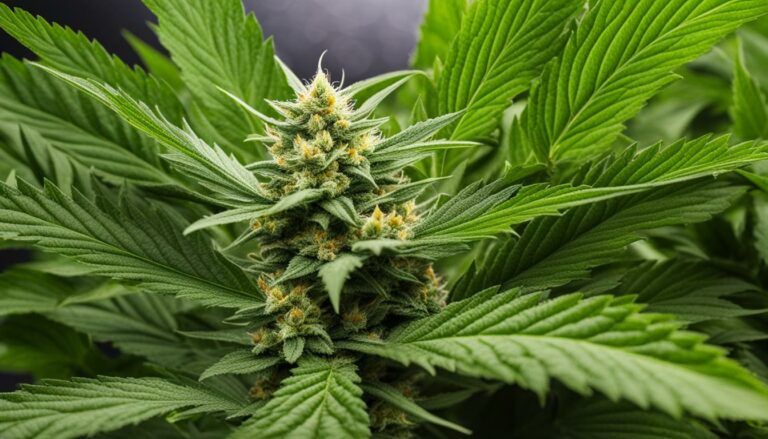The Importance of Proper Air Circulation in Cannabis Grows
Proper air circulation is essential for successful cannabis grows. Airflow helps strengthen stems, control temperature and humidity, reduce the chance of mold and pests, and promote overall plant health. Without proper air circulation, cannabis plants may suffer from slow growth, bud rot, and other issues. This article will explore the importance of air circulation in cannabis cultivation and provide tips for improving air circulation in grow rooms and gardens.
When it comes to growing cannabis, the quality of air circulation cannot be overstated. Just like humans, plants need fresh air to thrive. Without proper airflow, cannabis plants become stagnant and vulnerable to a host of problems.
Optimal air circulation is critical in cannabis grow rooms to ensure plants receive the necessary nutrients and environmental conditions to reach their full potential. By understanding the importance of air circulation and implementing effective techniques, growers can enhance the overall health, growth, and yields of their cannabis crops.
Understanding Air Circulation in Cannabis Grows
Air circulation is a vital aspect of successful cannabis cultivation. It plays a significant role in enhancing plant health, improving yields, and maintaining an optimal growing environment. By understanding the importance of good air circulation in cannabis crops and maximizing airflow, growers can unlock the full potential of their plants.
Good air circulation refers to the movement of air within a grow space. In natural outdoor settings, cannabis plants benefit from the gentle breeze, which strengthens their stems and protects them from pests. When growing indoors, it is crucial to recreate this airflow artificially. By providing proper air circulation, growers can strengthen the stems of their cannabis plants, control temperature and humidity levels, and reduce the risk of mold and pest infestations.
Maximizing air circulation in cannabis grows offers numerous benefits. It promotes stronger stems by simulating the bending action of wind, resulting in healthier and more robust plants. Additionally, it helps regulate temperature and humidity, ensuring even distribution of heat and moisture throughout the grow space. This, in turn, reduces the chances of mold growth and pest infestations, as the continuous airflow carries away excess moisture and makes it less conducive for pests to inhabit the plants. By prioritizing proper air circulation, growers can create an optimal growing environment that supports healthy plant growth and ultimately leads to better yields.
To optimize air circulation in cannabis grows, several techniques can be employed. These include using oscillating fans strategically placed above and below the canopy to ensure all parts of the plants receive airflow. Fans create a gentle breeze that simulates natural outdoor conditions and strengthens the stems. Additionally, implementing an exhaust system with an appropriate exhaust fan helps replace old air with fresh CO2-rich air and regulates temperature and humidity levels. Carbon filters can also be installed to eliminate the cannabis smell while maintaining proper airflow. By implementing these techniques, growers can enhance air circulation in their cannabis grows and achieve optimal results.
The Benefits of Proper Air Circulation in Cannabis Grows
Proper air circulation plays a crucial role in the cultivation of cannabis plants, offering a range of benefits that contribute to their overall health and productivity. By improving air circulation in cannabis gardens, growers can create an environment that promotes stronger stems, regulates temperature and humidity, and reduces the likelihood of mold and pest issues. This results in healthier plants with improved yields.
One of the key benefits of proper air circulation in cannabis cultivation is the strengthening of stems. When plants are exposed to gentle airflow, similar to natural wind, their stems become more robust and sturdy. This not only helps support the weight of the developing buds but also allows for better nutrient and water uptake, leading to healthier overall plant growth.
In addition to stem strength, proper air circulation also helps regulate temperature and humidity levels in cannabis grows. Airflow helps distribute heat evenly, preventing hotspots and ensuring that all parts of the plants receive adequate warmth. It also helps carry away excess moisture, reducing the chances of mold and preventing the proliferation of pests that thrive in high humidity environments.
Quote:
“By improving air circulation, cannabis growers can create a healthier and more productive growing environment.”
Improving air circulation in cannabis gardens is essential for maintaining optimal plant health and maximizing yields. By implementing techniques such as using oscillating fans to create a gentle breeze and installing an appropriate exhaust system, growers can ensure that airflow reaches all parts of the plants. Additionally, the use of carbon filters can help control odor, ensuring a more pleasant growing environment.
| Benefits of Proper Air Circulation in Cannabis Grows |
|---|
| Strengthens stems |
| Regulates temperature and humidity |
| Reduces mold and pest issues |
| Promotes healthier plant growth |
| Increases yields |
Techniques for Improving Air Circulation in Cannabis Grows
Proper air circulation is essential for successful cannabis grows. By implementing effective airflow techniques, cannabis growers can create an optimal growing environment that promotes plant health and maximizes yields. Here are some best practices for improving air circulation in cannabis cultivation:
- Use Oscillating Fans: Oscillating fans are a popular choice for improving air circulation in grow rooms. By positioning fans strategically above and below the canopy, growers can ensure that all parts of the plants receive airflow. This gentle breeze strengthens the stems, prevents stagnant air, and helps to control temperature and humidity levels.
- Invest in an Exhaust System: An exhaust system with an appropriate exhaust fan is essential for maintaining proper air circulation. The exhaust fan helps to remove old air and replace it with fresh CO2-rich air. This not only regulates temperature and humidity but also ensures that the plants receive a continuous supply of carbon dioxide for optimal growth.
- Consider Carbon Filters: To eliminate the distinct smell of cannabis, growers can install carbon filters as part of their ventilation system. These filters effectively remove odor-causing molecules from the air, ensuring a more pleasant growing environment while maintaining discretion.
By implementing these airflow techniques, cannabis growers can optimize air circulation in their grows, creating a healthier and more productive environment for their plants.
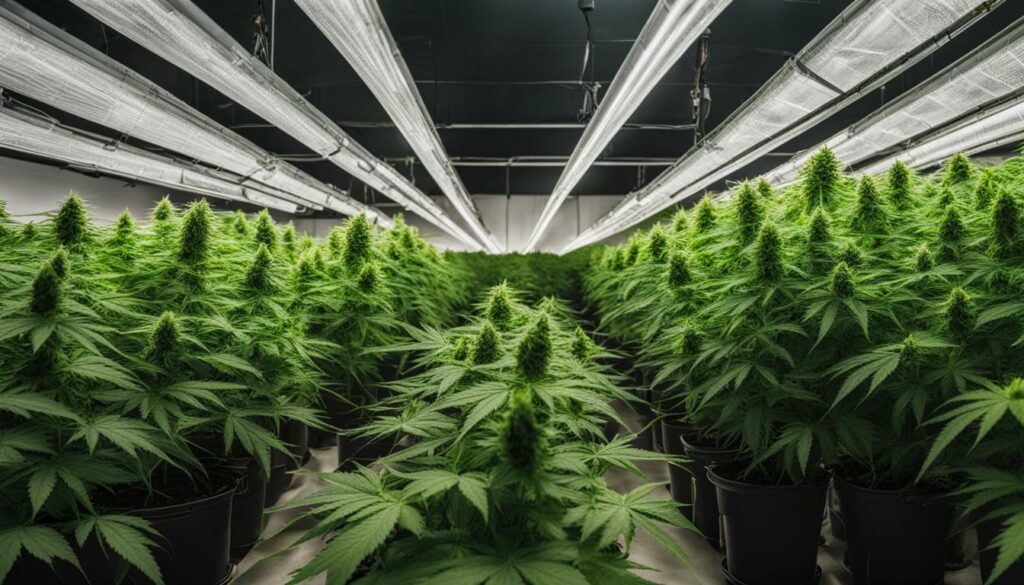
Benefits of Using Oscillating Fans:
“Oscillating fans are an effective tool for improving air circulation in cannabis grows. The gentle breeze created by these fans strengthens the stems, preventing the plants from becoming weak and spindly. Additionally, the airflow helps control temperature and humidity levels, reducing the likelihood of mold and pest infestations. By placing oscillating fans strategically, growers can create a more balanced and conducive growing environment.” – Cannabis Cultivation Expert
Choosing the Right Exhaust Fan:
| Factors to Consider | Benefits |
|---|---|
| CFM Rating | A higher CFM rating indicates a more powerful fan that can move air more efficiently. Choose an exhaust fan with a CFM rating suitable for the size of your grow space. |
| Noise Level | Consider the noise level of the exhaust fan, especially if the grow space is located in a residential area. Look for fans with a low noise output to minimize disruptions. |
| Energy Efficiency | Opt for an energy-efficient exhaust fan to reduce electricity costs without compromising air circulation. |
Placing Oscillating Fans for Optimal Air Circulation in Cannabis Grows
Proper placement of oscillating fans is essential for ensuring optimal air circulation in indoor cannabis grows. By strategically positioning these fans, growers can create a gentle breeze that reaches all parts of the plants, promoting healthy growth and preventing issues such as mold and pests. Here are some tips for effectively placing oscillating fans in cannabis gardens:
- Position fans above and below the canopy: To ensure that all parts of the plants receive airflow, it is important to place fans both above and below the canopy. This helps to distribute air more evenly and strengthen the stems.
- Avoid placing fans too close: While it is important to provide adequate airflow, placing fans too close to the plants can cause excessive stress and wind-burn symptoms. Maintain a distance of at least a few feet to create a gentle breeze.
- Angle fans towards the canopy: Directing the airflow towards the canopy helps to strengthen the stems and reduce the risk of humid microclimates forming within the canopy, which can lead to mold and pest issues.
- Vary fan positions and angles: Experiment with different fan positions and angles to find the most effective airflow pattern for your specific grow space. This may involve adjusting fan height, oscillation range, and speed to achieve the desired results.
By following these tips and regularly monitoring plant health and growth, cannabis growers can optimize air circulation in their indoor grows and create an environment that promotes healthy and productive plants.
Example Table: Oscillating Fan Placement
| Fan Position | Benefits |
|---|---|
| Above the canopy | Provides airflow to the upper parts of the plants, strengthens stems, and helps control temperature and humidity. |
| Below the canopy | Ensures airflow to the lower parts of the plants, promotes root health, and helps prevent stagnant air pockets. |
| Angled towards the canopy | Directs airflow to the leaves and stems, strengthens plant structure, and reduces the risk of mold and pest issues. |
| Varied positions and angles | Allows for customization based on grow space layout and plant requirements, optimizing airflow distribution. |
Choosing the Right Exhaust System for Air Circulation in Cannabis Grows
When it comes to maintaining proper air circulation in cannabis grows, choosing the right exhaust system is essential. An exhaust fan plays a crucial role in ensuring that old air is replaced with fresh CO2-rich air, helping to regulate temperature and humidity levels within the grow space. However, selecting the proper exhaust fan goes beyond simply picking any fan from the market. It requires considering the CFM (cubic feet per minute) rating to determine the fan’s air-moving capacity.
The CFM rating is calculated based on the dimensions of the grow space and the desired air exchange rate. This ensures that the air within the grow room is continuously refreshed, allowing the plants to receive an adequate supply of fresh CO2. To calculate the required CFM, measure the length, width, and height of the grow space. Multiply these measurements together to determine the cubic footage. Then, divide the cubic footage by the desired air exchange rate (typically 1-5 minutes) to find the required CFM. This calculation will help growers select the appropriate exhaust fan for their specific needs.
By choosing the right exhaust fan with the proper CFM, cannabis growers can optimize air circulation, prevent the buildup of heat and moisture, and ensure a healthier growing environment for their plants.

Table: Exhaust Fan Options and CFM Requirements
| Grow Space Size (in cubic footage) | Desired Air Exchange Rate | Required CFM | Recommended Exhaust Fan |
|---|---|---|---|
| 100 – 500 | 1 – 5 minutes | 100 – 500 CFM | Standard Inline Fan |
| 500 – 1,000 | 1 – 4 minutes | 500 – 1,000 CFM | Centrifugal Inline Fan |
| 1,000 – 2,000 | 1 – 3 minutes | 1,000 – 2,000 CFM | High-Powered Inline Fan |
Installing a Carbon Filter for Odor Control in Cannabis Grows
Proper odor control is crucial for cannabis growers who prioritize discretion and want to avoid any unwanted attention. Using carbon filters is an effective solution to eliminate the distinct smell of cannabis in grow rooms. These filters are designed to remove odor-causing molecules from the air, ensuring that the scent is neutralized before it is vented out.
By installing a carbon filter as part of the exhaust system, growers can effectively control the odor produced by cannabis plants. As the air passes through the carbon filter, the activated carbon traps and absorbs the odor molecules, resulting in a much more pleasant growing environment.
Carbon filters are highly effective in eliminating the cannabis smell, making them an essential tool for growers who need to maintain discretion and prevent the scent from escaping their grow rooms.
Benefits of Carbon Filters in Cannabis Cultivation
Using carbon filters in cannabis cultivation offers several important benefits. Firstly, it helps growers comply with legal regulations and maintain the privacy of their operation by eliminating the distinct smell associated with cannabis. This is especially crucial for growers operating in areas where the odor can attract unwanted attention or pose legal risks.
Furthermore, carbon filters contribute to creating a more enjoyable and comfortable environment for growers and their plants. By removing the pungent cannabis scent, carbon filters help create a pleasant workspace for growers to tend to their plants without the overwhelming odor. This can significantly improve the overall experience of cannabis cultivation.
Overall, carbon filters are an indispensable tool for cannabis growers who prioritize discretion and want to optimize their growing environment. By neutralizing the cannabis smell, these filters contribute to a more pleasant atmosphere and help growers comply with regulations, ensuring the success of their cultivation endeavors.
| Benefits of Carbon Filters | |
|---|---|
| Eliminates the distinct smell of cannabis | |
| Complies with legal regulations and maintains discretion | |
| Creates a more enjoyable and comfortable working environment |
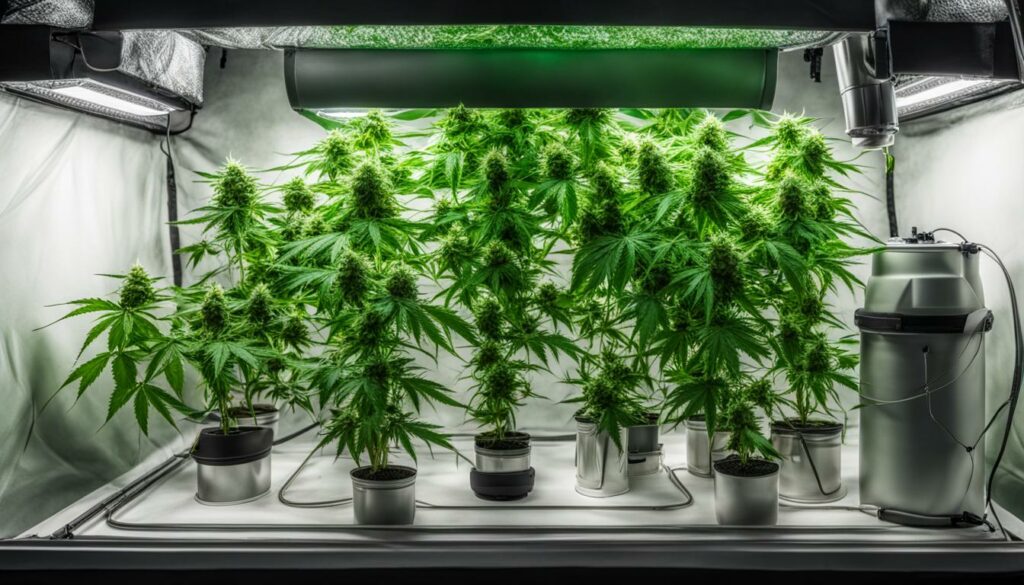
Installing a carbon filter as part of the exhaust system is a vital step in controlling odor in cannabis grows. By neutralizing the cannabis scent, growers can prioritize discretion, comply with regulations, and create a more pleasant environment for both themselves and their plants. With the benefits of carbon filters in cannabis cultivation, growers can confidently cultivate their crops while maintaining privacy and optimizing their growing experience.
DIY Stealth Exhaust System for Air Circulation in Cannabis Grows
Creating a discreet ventilation system is essential for cannabis growers who need to maintain discretion. By following a step-by-step process, you can create a DIY stealth exhaust system that effectively removes air and odor without attracting unwanted attention.
To start, gather the following materials: duct tape, foam, wicker blinds, and corrugated plastic sheets. These items are affordable and readily available, making them ideal for creating a budget-friendly ventilation solution.
Begin by using the foam to seal any gaps in the grow room or tent. This will prevent air leaks and ensure that the air is properly directed through the exhaust system. Next, construct a frame using the wicker blinds and attach it to the opening where the exhaust fan will be installed. This frame will serve as a cover, disguising the fan and giving your ventilation system a more inconspicuous appearance.

Once the frame is in place, use the duct tape to secure the corrugated plastic sheets to the frame, creating a duct that will direct the air outside. Make sure to properly seal all connections with duct tape to prevent any air leaks. Finally, connect the exhaust fan to the duct using more duct tape, ensuring a secure and airtight connection.
By following these simple steps, you can create a DIY stealth exhaust system that effectively removes air and odor from your cannabis grow without drawing unwanted attention. This cost-effective solution allows you to maintain discretion while ensuring proper air circulation for optimal plant health and productivity.
Ventilation Tips for Greenhouse Cannabis Grows
Proper ventilation plays a crucial role in maintaining optimal airflow in greenhouse cannabis cultivation. By ensuring a steady exchange of air, growers can regulate temperature, humidity, and carbon dioxide levels, creating an ideal environment for healthy plant growth. Here are some valuable tips for ventilating cannabis in greenhouses:
1. Install Exhaust Fans
An exhaust fan system is essential for expelling hot air from the greenhouse and bringing in fresh, cooler air. By strategically placing exhaust fans near the roof or sidewalls, growers can facilitate the removal of excess heat and humidity. This helps prevent the buildup of moisture, reducing the risk of mold and pests.
2. Utilize Intake Vents
Intake vents are equally important for facilitating proper airflow in greenhouse cannabis grows. These vents allow fresh air to enter the greenhouse by taking advantage of natural wind currents. To maximize their effectiveness, intake vents should be placed on the opposite side of the exhaust fans, creating a cross-ventilation system that promotes consistent air circulation.
3. Monitor and Control Temperature
Regularly monitoring and controlling the temperature inside the greenhouse is crucial for maintaining proper airflow. By using temperature sensors and automated climate control systems, growers can adjust ventilation settings to ensure that the temperature remains within the optimal range for cannabis cultivation. This helps promote stable plant growth and prevents the risk of heat stress.
4. Consider Supplemental Fans
In addition to exhaust fans and intake vents, supplemental fans can be used to further enhance air circulation in the greenhouse. These fans help create a gentle breeze that mimics natural wind, strengthening the plants’ stems and preventing stagnant air pockets. By strategically placing these fans throughout the greenhouse, growers can ensure that all areas receive adequate airflow.
By following these ventilation tips, cannabis growers can maintain proper airflow in greenhouse cultivation, creating an optimal growing environment for their plants. Remember, ensuring consistent air circulation helps control temperature, humidity, and pests, ultimately promoting healthier and more productive cannabis grows.
Environmental Factors Affecting Air Circulation in Cannabis Grows
Proper air circulation in cannabis grows is not solely dependent on airflow techniques and ventilation systems. Several environmental factors also play a significant role in optimizing air circulation and creating an ideal growing environment for cannabis plants. By controlling these factors, growers can enhance the effectiveness of their air circulation strategies and promote better plant health and yields.
Temperature
The temperature inside the grow room has a direct impact on air circulation. Higher temperatures can lead to stagnant air, hindering airflow and creating an unfavorable environment for plant growth. On the other hand, excessively low temperatures can slow down the movement of air molecules. It is crucial to maintain a consistent and optimal temperature range, usually between 70 to 85 degrees Fahrenheit (20 to 30 degrees Celsius), to encourage proper air circulation.
Humidity
Humidity levels also influence air movement within the grow room. High humidity can cause moisture to condense on plant surfaces, inhibiting air circulation and creating a breeding ground for mold and pests. Conversely, low humidity can result in dry air that impedes the buoyancy of air molecules. Maintaining an ideal humidity range of 50 to 60% is essential for promoting proper air circulation and preventing moisture-related issues.
Light
The intensity and positioning of light sources can impact air circulation in cannabis grows. Dense canopy growth can obstruct the flow of air, especially if plants are closely spaced. Proper light distribution and positioning can help minimize this obstruction, allowing air to move more freely throughout the grow space. By providing adequate and evenly distributed lighting, growers can optimize air circulation and promote healthier plant development.
CO2 Levels
Carbon dioxide (CO2) is essential for photosynthesis and plant growth. Adequate CO2 levels enhance the efficiency of air circulation by promoting faster and healthier plant metabolism. Growers can control CO2 levels by implementing CO2 enrichment systems or utilizing natural CO2 sources such as propane heaters or mushroom substrate. Maintaining optimal CO2 levels, typically around 1200 to 1500 parts per million (ppm), helps maximize air circulation and overall plant productivity.
| Environmental Factor | Optimal Range | Impact on Air Circulation |
|---|---|---|
| Temperature | 70-85°F (20-30°C) | Ensures consistent airflow and prevents stagnation |
| Humidity | 50-60% | Prevents condensation and promotes moisture balance |
| Light | Even distribution | Minimizes obstruction and facilitates air movement |
| CO2 Levels | 1200-1500 ppm | Enhances plant metabolism and air circulation efficiency |
By considering and controlling these environmental factors, cannabis growers can optimize air circulation in their grows and create a harmonious and productive growing environment. A holistic approach to cultivation that encompasses both airflow techniques and environmental management is key to unlocking the full potential of cannabis plants.
The Key to Better Cannabis Yields: Proper Air Circulation
Proper air circulation plays a crucial role in maximizing cannabis yields. By prioritizing good airflow, cannabis growers can unlock a range of benefits that directly impact the quality and productivity of their crops. Maximizing air circulation not only strengthens stems and promotes overall plant health but also helps regulate temperature and humidity levels, reducing the risk of mold and pest infestations.
Airflow is essential for cannabis plants to thrive, as it ensures the even distribution of vital elements such as carbon dioxide and heat throughout the grow space. This creates an optimal growing environment, allowing plants to grow vigorously and produce bigger, denser buds. When air circulation is improved, plants have improved access to fresh CO2 and are better equipped to absorb nutrients, resulting in higher yields.
Furthermore, proper air circulation supports the overall health of cannabis plants. It helps prevent the development of stagnant microclimates and helps remove excess moisture, making it difficult for mold and pests to take hold. By maximizing air circulation, growers can create a dynamic and well-balanced ecosystem in their grow rooms or gardens, leading to healthier and more robust plants.
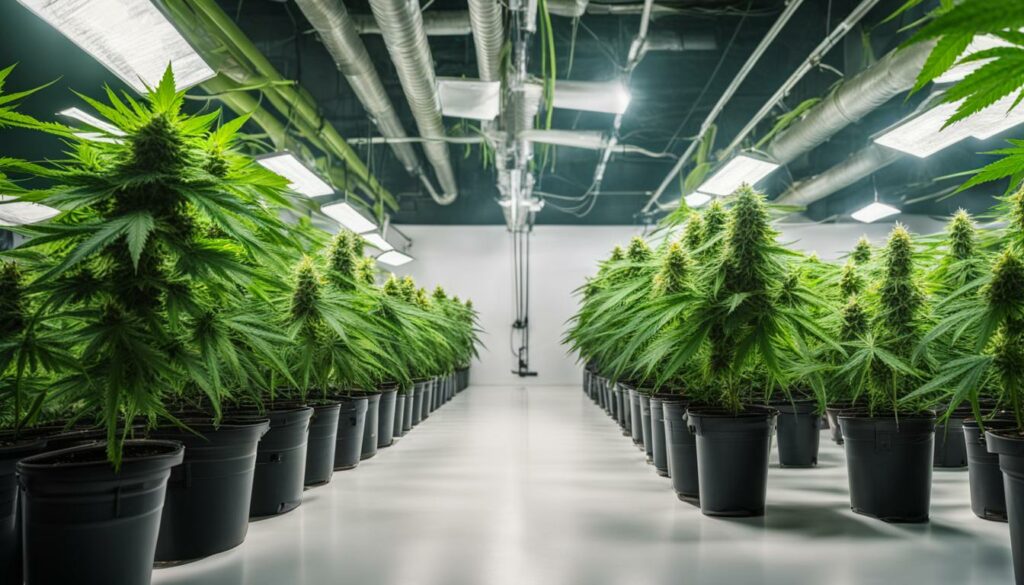
The Benefits of Air Circulation in Cannabis Yield
The benefits of air circulation in cannabis yield are numerous. Stronger plants with well-developed stems can support the weight of larger buds, minimizing the risk of branches breaking or bending under the pressure. Controlled temperature and humidity levels foster optimal photosynthesis and transpiration rates, ensuring that plants can efficiently convert light into energy and water into vapor.
Additionally, improved air circulation reduces the risk of plants suffering from stagnant air pockets, which can lead to the development of bud rot or other diseases. By promoting consistent air movement, cannabis growers can create an environment that is less conducive to the growth of pathogens and pests, ultimately safeguarding the health and productivity of their crops.
Ultimately, by recognizing the importance of proper air circulation in cannabis cultivation and implementing strategies to maximize airflow, growers can set themselves up for success. With healthier plants, regulated temperature and humidity, and reduced risks of mold and pests, growers can achieve better cannabis yields and produce high-quality crops that boast robust flavor profiles, potent cannabinoid content, and impressive visual appeal.
Related Articles
- Why Is Air Circulation Crucial in Cannabis Grows?
- How to Set Up Effective Ventilation in Your Cannabis Grow Room?
- What Are the Risks of Poor Air Circulation for Cannabis Plants?
- Can Fans and Filters Improve the Health of Your Cannabis Plants?
- How to Prevent Mold and Mildew in Cannabis Grows with Proper Air Circulation?
Conclusion
In conclusion, proper air circulation is crucial for successful cannabis grows. Good airflow helps strengthen stems, regulate temperature and humidity, prevent mold and pest issues, and promote overall plant health. By implementing techniques such as using oscillating fans, choosing the right exhaust system, installing carbon filters, and maintaining proper ventilation in greenhouse grows, growers can optimize air circulation and create an ideal growing environment.
By prioritizing air circulation, cannabis growers can achieve better yields and improve the quality of their crops. The benefits of proper air circulation cannot be overstated, as it contributes to stronger and healthier plants, leading to higher yields. When the air is properly circulated, plants receive the necessary nutrients, CO2, and oxygen needed for optimal growth. This allows them to reach their full potential and produce high-quality cannabis.
By investing in the right equipment and following best practices for air circulation, growers can create a thriving environment for their cannabis plants. They can minimize the risk of mold and pests, control temperature and humidity levels, and ensure that the plants have access to fresh air. All of these factors work together to create an environment where cannabis plants can thrive and produce abundant yields.
FAQ
What is air circulation in cannabis grows?
Air circulation refers to the movement of air within a cannabis grow space. It involves creating airflow to strengthen stems, control temperature and humidity, and reduce the chances of mold and pests.
Why is proper air circulation important in cannabis cultivation?
Proper air circulation is crucial for successful cannabis grows as it strengthens stems, controls temperature and humidity, reduces the chances of mold and pests, and promotes overall plant health.
How does air circulation benefit cannabis plants?
Air circulation benefits cannabis plants by strengthening stems, controlling temperature and humidity, reducing the chances of mold and pests, and overall promoting healthier and more productive plant growth.
What techniques can be used to improve air circulation in cannabis grows?
Techniques such as using oscillating fans strategically, implementing an appropriate exhaust system, and using carbon filters can improve air circulation in cannabis grows.
How should oscillating fans be placed for optimal air circulation in cannabis grows?
Oscillating fans should be strategically placed above and below the canopy of cannabis plants to ensure that all parts of the plants receive airflow.
What should be considered when choosing an exhaust system for air circulation in cannabis grows?
When choosing an exhaust fan, the CFM (cubic feet per minute) rating should be considered. It indicates the amount of air the fan can move per minute and should be calculated based on the dimensions of the grow space and desired air exchange rate.
How can carbon filters be used for odor control in cannabis grows?
Carbon filters can be installed as part of the exhaust system to eliminate the cannabis smell. They work by passing the air through the carbon filter, neutralizing the odor-causing molecules before venting out.
Is there a cost-effective solution for creating a stealth exhaust system in cannabis grows?
Yes, a DIY stealth exhaust system can be created using inexpensive materials such as duct tape, foam, wicker blinds, and corrugated plastic sheet. This allows for proper air circulation without attracting unwanted attention.
How can proper ventilation be maintained in greenhouse cannabis grows?
Proper ventilation in greenhouse cannabis grows can be maintained by having windows and vents that can be opened to allow fresh air to enter and hot air to escape. Fans and exhaust systems can also be used to enhance air circulation.
What other environmental factors can impact air circulation in cannabis grows?
Temperature, humidity, light, and CO2 levels are other environmental factors that can impact air circulation in cannabis grows. It is important to monitor and adjust these factors regularly for optimal results.
How does proper air circulation contribute to better cannabis yields?
Proper air circulation strengthens stems, controls temperature and humidity, reduces the chances of mold and pests, and promotes overall plant health. These factors ultimately lead to healthier and more productive plants, resulting in better cannabis yields.


